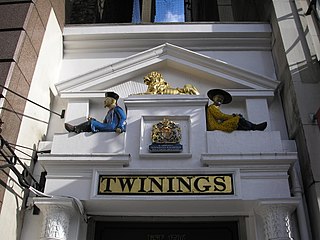
Sir Thomas Bodley was an English diplomat and scholar who founded the Bodleian Library in Oxford.
Richard Glover was an English poet and politician.

Edmond Malone was an Irish Shakespearean scholar and editor of the works of William Shakespeare.

George SteevensFRS was an English Shakespearean commentator.

William Gerard Hamilton, was an English statesman and Irish politician, popularly known as "Single Speech Hamilton".

Brook Street is an axial street in the exclusive central London district of Mayfair. Most of it is leasehold, paying ground rent to and seeking lease renewals from the reversioner, that since before 1800, has been the Grosvenor Estate. Named after the Tyburn that it crossed, it was developed in the first half of the 18th century and runs from Hanover Square to Grosvenor Square. The western continuation is called Upper Brook Street; its west end faces Brook Street Gate of Hyde Park. Both sections consisted of neo-classical terraced houses, mostly built to individual designs. Some of them were very ornate, finely stuccoed and tall-ceilinged, designed by well known architects for wealthy tenants, especially near Grosvenor Square, others exposed good quality brickwork or bore fewer expensive window openings and embellishments. Some of both types survive. Others have been replaced by buildings from later periods.

Jonathan's Coffee House was a significant meeting place in London in the 17th and 18th centuries, famous as the original site of the London Stock Exchange.

Eric Robertson Dodds was an Irish classical scholar. He was Regius Professor of Greek at the University of Oxford from 1936 to 1960.
Sir Henry Cuffe was an English writer and politician, executed during the reign of Queen Elizabeth I of England, for treason.

Essex House was a house that fronted the Strand in London. Originally called Leicester House, it was built around 1575 for Robert Dudley, 1st Earl of Leicester, and was renamed Essex House after being inherited by his stepson, Robert Devereux, 2nd Earl of Essex, after Leicester's death in 1588. The poet Philip Sidney lived in Leicester House for some time.

The Twinings Museum was a small temporary museum adjacent to the Twinings shop at 216, Strand, in London, England.

Samuel Ireland, English author and engraver, is best remembered today as the chief victim of the Ireland Shakespeare forgeries created by his son, William Henry Ireland.

The Ireland Shakespeare forgeries were a cause célèbre in 1790s London, when author and engraver Samuel Ireland announced the discovery of a treasure-trove of Shakespearean manuscripts by his son William Henry Ireland. Among them were the manuscripts of four plays, two of them previously unknown.
Peter Martin is an English literature scholar, biographer, and an 18th century garden historian. He was educated and has taught in the United States. He lives in England and Spain.

The spelling of William Shakespeare's name has varied over time. It was not consistently spelled any single way during his lifetime, in manuscript or in printed form. After his death the name was spelled variously by editors of his work, and the spelling was not fixed until well into the 20th century.

William Shakespeare's handwriting is known from six surviving signatures, all of which appear on legal documents. It is believed by many scholars that the three pages of the handwritten manuscript of the play Sir Thomas More are also in William Shakespeare's handwriting. This is based on many studies by a number of scholars that considered handwriting, spelling, vocabulary, literary aspects, and more.

Anthony Malone was an Irish lawyer and politician.
Richard Malone, 1st Baron Sunderlin was an Anglo-Irish politician and peer.

The Devereux is a pub at No. 20 Devereux Court, off Essex Street, London WC2.

Devereux Court, a street in the City of Westminster located just south of the Strand and east of Essex Street, is completely pedestrianised. This narrow lane is lined with well-preserved seventeenth-century buildings. The court's distinctive dog-leg layout has remained unchanged since its establishment in the 1670s on the grounds of Essex House, a stately home renowned for its expansive gardens.
















